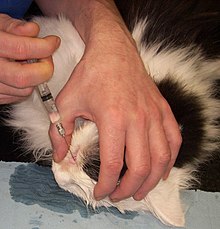Nasolacrimal duct obstruction
This article needs additional citations for verification. (August 2012) |
| Nasolacrimal duct obstruction | |
|---|---|
| Other names | Dacryocystitis |
 | |
| Tear system consists of lacrimal gland (a), punctums (b,e), canalicules (c,f), lacrimal sac (d). Tear is then drained through nasolacrimal duct (g) into nasal cavity | |
| Specialty | Ophthalmology |
| Differential diagnosis | Tears arising from lacrimal sac fistula.[1] |
Nasolacrimal duct obstruction is the obstruction of the
Sign and symptoms
Excessive tearing is the most common complaint of patients with nasolacrimal duct obstruction, followed by acute or chronic infections.[3] Pain at the side of the nose suggests dacryocystitis.
Nasolacrimal duct obstruction is more common with increasing age and more common in females than males.[3]
Cause
Involutional stenosis
Involutional stenosis is probably the most common cause of nasolacrimal duct obstruction in older people. It affects women twice as frequently as men. Although the inciting event in this process is unknown, clinicopathologic study suggests that compression of the lumen of the nasolacrimal duct is caused by inflammatory infiltrates and edema. This may be the result of an unidentified infection or possibly an autoimmune disease.[citation needed]
Dacryolith
Dacryoliths or cast formation, within the lacrimal sac can also produce obstruction of the nasolacrimal duct.
Sinus disease
Sinus disease often occurs in conjunction with, and in other instances may contribute to the development of nasolacrimal duct obstruction. Patients should be asked about previous sinus surgery, as the nasolacrimal duct is sometimes damaged when the maxillary sinus ostium is being enlarged anteriorly.
Trauma
Naso-orbital fractures may involve the nasolacrimal duct. Early treatment by fracture reduction with stenting of the entire lacrimal drainage system should be considered. However, such injuries are often not recognized or are initially neglected as more serious injuries are managed. In such cases, late treatment of persistent epiphora usually requires dacryocystorhinostomy.
Inflammatory disease
Granulomatous disease, including
Lacrimal plugs
As with similar cases of canalicular obstruction, dislodged punctal and canalicular plugs can migrate to and occlude the nasolacrimal duct.
Neoplasm
Congenital
Congenital nasolacrimal duct obstruction, or dacryostenosis, occurs when the lacrimal duct has failed to open at the time of birth, most often due to an imperforate membrane at the valve of Hasner.[4] Around 6% of infants have congenital nasolacrimal duct obstruction, or dacryostenosis, usually experiencing a persistent watery eye even when not crying. If a secondary infection occurs (dacryocystitis), purulent (yellow / green) discharge may be present.
Most cases resolve spontaneously, with
Referral to an
Diagnosis
Evaluation is in the form of a dye disappearance test followed by irrigation test. By using this sequence (with modifications) as a guide, the physician can frequently streamline diagnostic testing.
Dye disappearance test
The dye disappearance test is useful for assessing the presence or absence of adequate lacrimal outflow, especially in unilateral cases. It is more heavily relied upon in children, in whom lacrimal irrigation is impossible without deep sedation. Using a drop of sterile 2% fluorescein solution or a moistened fluorescein strip, the examiner instills fluorescein into the conjunctival fornices of each eye and then observes the tear film, preferably with the cobalt blue filter of the slit lamp. Persistence of significant dye and, particularly asymmetric clearance of the dye from the tear meniscus over a 5-minute period indicate an obstruction. If the dye disappearance test result is normal, severe lacrimal drainage dysfunction is highly unlikely. The Jones tests are variations of the dye disappearance test.
Irrigation test

In irrigation test, a lacrimal irrigation cannula is passed into the punctum and advanced through the canaliculus to the lacrimal fossa. Clear water or saline is then irrigated through the cannula. If fluid passes into the nose without reflux out of the opposite canaliculus, the system is patent. If no fluid passes but it all comes back through either punctum, nasolacrimal duct obstruction is present.
Management
Intubation and stenting
Some clinicians believe that partial stenosis of the nasolacrimal duct with symptomatic epiphora sometimes responds to surgical intubation of the entire lacrimal drainage system. This procedure should be performed only if the tubes can be passed easily. In complete nasolacrimal duct obstruction, intubation alone is not effective, and a dacryocystorhinostomy should be considered.
Dacryocystorhinostomy
A dacryocystorhinostomy is the treatment of choice for most patients with acquired nasolacrimal duct obstruction. Surgical indications include recurrent dacryocystitis, chronic mucoid reflux, painful distension of the lacrimal sac, and bothersome epiphora. For patients with dacryocystitis, active infection should be cleared, if possible, before a dacryocystorhinostomy is performed.[2]
See also
References
- ISBN 978-0-323-05386-0.
This tearing is different (from Dacryocystitis), as it originates from the fistula located below the eyelid on the cheek (may be associated with nasolacrimal duct obstruction).
- ^ ISBN 9780323043328.
- ^ PMID 28231605.
- ^ Blocked tear ducts in infants, Pediatric Views, June 2006 http://www.childrenshospital.org/views/june06/blocked_tear_ducts.html Archived 2012-07-08 at the Wayback Machine
- PMID 9274552.
- PMID 17307001.
- PMID 28700811.
